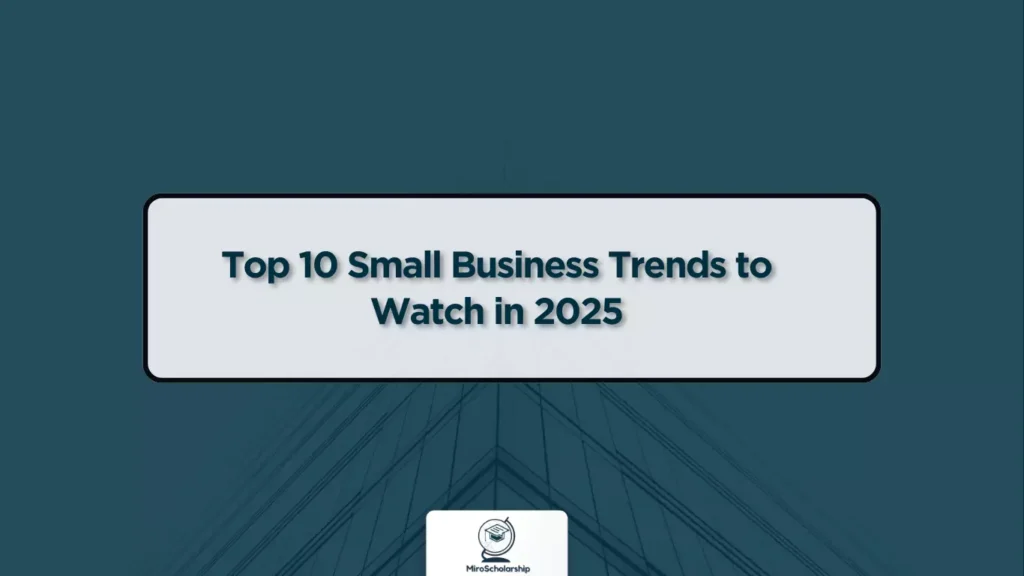Small businesses have always been at the forefront of innovation, quickly adapting to market shifts and leveraging new technologies to stay competitive. As we look toward 2025, several trends are set to shape the small business landscape. This article highlights the top 10 small business trends for 2025 that entrepreneurs should embrace to thrive in an increasingly dynamic market.
1. The Evolution of Remote Work
Remote work has moved from being a temporary solution to a permanent aspect of modern business operations. However, it continues to evolve as businesses refine their approaches to flexibility and collaboration.
Hybrid Work Models:
More businesses are adopting hybrid work setups, combining the benefits of in-office collaboration and remote flexibility. This approach not only accommodates employees’ preferences but also helps businesses remain agile and responsive in a globalized market.
Enhanced Collaboration Tools:
Tools like Slack, Trello, Microsoft Teams, and Zoom are improving workflows by adding features such as AI-driven task automation and virtual coworking spaces, making remote work even more efficient and seamless.
Remote Work Culture:
Building a positive remote work culture is becoming a priority for businesses. Offering virtual team-building activities and establishing clear communication protocols are key strategies for keeping remote teams engaged and productive.
Key Insight:
Small businesses that invest in cutting-edge remote work solutions and foster a positive remote work culture will not only remain attractive to top talent but also ensure operational efficiency.
2. Subscription-Based Business Models
The subscription economy continues to grow, offering businesses a predictable revenue stream while fostering stronger customer relationships.
Success Stories:
Companies like Dollar Shave Club and Blue Apron have capitalized on subscription models, offering convenience and curated experiences that encourage long-term customer loyalty.
Scalability:
Businesses can scale by introducing tiered subscription options or bundling services to attract a broader customer base and cater to varying customer needs.
Recurring Revenue:
The subscription model ensures steady cash flow, allowing businesses to focus on growth rather than constantly acquiring new customers.
Recommendation:
Whether it’s software, fitness services, or even pet products, small businesses should consider exploring subscription-based offerings to enhance customer loyalty and stabilize revenue.
3. The Rise of Sustainable and Ethical Brands
Consumers, particularly Millennials and Gen Z, are increasingly prioritizing sustainability and ethical business practices when choosing brands. Small businesses that embrace sustainability can strengthen their brand image and attract eco-conscious customers.
Eco-Friendly Initiatives:
Brands are adopting sustainable packaging, reducing carbon footprints, and sourcing materials responsibly. Offering eco-friendly products can make a significant impact, especially when aligned with growing consumer awareness.
Social Responsibility:
Businesses that actively support social causes or adopt ethical labor practices often gain a competitive edge in the market. Supporting environmental and social causes can lead to deeper customer loyalty and advocacy.
Transparency Matters:
Customers are more likely to trust businesses that share their sustainability efforts. Sharing these efforts on social media or through website content enhances transparency and builds brand loyalty.
Pro Tip:
Adopting sustainable practices is not only good for the planet but also helps businesses resonate with environmentally conscious consumers, strengthening their market position.
4. Social Commerce is Booming
Social commerce is transforming platforms like Instagram, TikTok, and Pinterest into powerful sales channels. These platforms are evolving beyond brand awareness to directly facilitate purchases.
Shoppable Posts:
Features like Instagram Shopping allow users to make purchases directly within the app, seamlessly blending entertainment and shopping. Small businesses should leverage these features to drive conversions directly from social media.
Influencer Marketing:
Partnering with influencers continues to be a highly effective way to increase brand awareness and drive sales. By collaborating with influencers who resonate with their audience, businesses can reach new customers and build credibility.
Short-Form Content:
Creative and engaging short videos showcasing products are driving high conversion rates on platforms like TikTok and Instagram Reels. Small businesses should focus on creating engaging, shareable content that informs and entertains.
Recommendation:
Small businesses should focus on building a strong presence on social platforms and creating content that entertains, informs, and converts, using the growing potential of social commerce.
5. Mobile Payment Adoption
Mobile payment systems have become an integral part of modern business operations, providing customers with a seamless and secure checkout experience. Small businesses must embrace these systems to stay competitive.
Convenience for Consumers:
Mobile wallets like Apple Pay, Google Wallet, and PayPal simplify transactions, making them quicker and more secure. The ability to pay via mobile devices has become a necessity for a fast and frictionless shopping experience.
Contactless Payments:
The demand for touch-free payments has surged, especially post-pandemic. Offering contactless payment methods ensures a safer, more efficient transaction experience for customers.
POS System Upgrades:
Small businesses are integrating mobile-friendly point-of-sale (POS) systems to accommodate mobile payments and enhance the checkout experience, especially in brick-and-mortar locations.
Recommendation:
Adopting mobile payment solutions not only enhances customer satisfaction but also aligns with consumer expectations for secure, convenient, and modern payment methods.
6. Employee Well-Being Takes Center Stage
As competition for talent grows, small businesses are prioritizing employee satisfaction and well-being to attract and retain top talent.
Flexible Work Arrangements:
Offering flexible schedules and remote options allows businesses to retain employees while promoting a better work-life balance. Flexibility has become a major factor in employee retention.
Mental Health Support:
Providing access to mental health services, such as counseling and wellness programs, helps create a supportive workplace. A focus on mental well-being fosters loyalty and increases productivity.
Career Development Opportunities:
Investing in career development through training programs, mentorship, and clear growth paths motivates employees to stay and grow with the company, reducing turnover.
Pro Tip:
By prioritizing employee well-being, businesses can create a productive and loyal workforce, contributing to the overall success of the business.
7. Augmented Reality (AR) for Product Visualization
Augmented reality is revolutionizing how consumers interact with products online, particularly in the retail and e-commerce sectors.
Virtual Fitting Rooms:
Retail businesses, especially in fashion, are using AR to let customers virtually try on clothing. This immersive experience reduces buyer hesitation and boosts conversions.
3D Product Demos:
Home decor and furniture brands use AR to show how items will look in a consumer’s space, helping customers visualize products in real-world settings before making a purchase.
Enhanced Shopping Experience:
AR enhances the shopping experience by providing real-world context for products, which increases customer confidence and reduces returns.
Recommendation:
Small businesses should explore AR tools to elevate the online shopping experience and stand out in competitive markets by offering unique and interactive ways for customers to interact with their products.
8. The Critical Need for Cybersecurity
As businesses continue to rely more heavily on digital platforms, robust cybersecurity is becoming essential. Cyber threats are more sophisticated, and small businesses must safeguard sensitive data to protect their reputation and customer trust.
Adoption of Security Tools:
Solutions like LastPass, Malwarebytes, and Bitdefender offer advanced protection against cyber threats and help secure business operations, particularly for e-commerce businesses.
Data Protection Compliance:
Businesses must comply with data protection regulations like GDPR or CCPA to avoid penalties and safeguard customer information.
Employee Training:
Educating staff on cybersecurity best practices—such as identifying phishing attempts and using strong passwords—prevents breaches and strengthens overall security.
Pro Tip:
Investing in cybersecurity measures is not just a precaution but a crucial step to maintaining business integrity and building trust with customers.
9. AI-Powered Customer Support
Artificial intelligence is transforming customer service by improving efficiency, reducing costs, and providing more personalized support.
Chatbots and Virtual Assistants:
AI tools like ChatGPT can handle inquiries, process orders, and provide personalized recommendations 24/7. This reduces the burden on customer service teams and enhances customer experience.
Customer Insights:
AI analyzes customer behavior to predict preferences, allowing businesses to offer more tailored solutions and improve the overall customer experience.
Scalability:
AI-driven customer support systems can handle higher customer volumes without the need for additional human resources, allowing businesses to scale effectively.
Recommendation:
Small businesses can enhance customer satisfaction and foster long-term relationships by adopting AI-powered customer support solutions.
10. The Growing Importance of Local SEO
Local search optimization is critical for small businesses targeting nearby customers. Enhancing your local search presence helps increase visibility and attract foot traffic to physical locations.
Google My Business:
Claiming and optimizing a Google My Business listing ensures visibility in local search results and improves your business’s online presence.
Online Reviews:
Encouraging customers to leave positive reviews on platforms like Google and Yelp builds credibility and boosts rankings in local searches.
Localized Content:
Creating blog posts or web pages tailored to local interests and keywords enhances search engine visibility and drives local traffic to your website or store.
Recommendation:
By focusing on local SEO, small businesses can attract more foot traffic, increase their online presence, and connect with customers in their communities.
Conclusion
The small business trends of 2025 highlight a blend of technological innovation, consumer-driven changes, and a renewed focus on sustainability. By staying ahead of these trends, small businesses can adapt to the ever-evolving market landscape and position themselves for success.
From leveraging AR and AI to optimizing for local SEO and prioritizing employee well-being, the key to thriving in 2025 lies in embracing innovation and maintaining a customer-centric approach. Entrepreneurs who invest in these strategies will not only survive but thrive in an increasingly competitive marketplace.
Read More : Artificial Intelligence: Revolutionizing Business Operations


